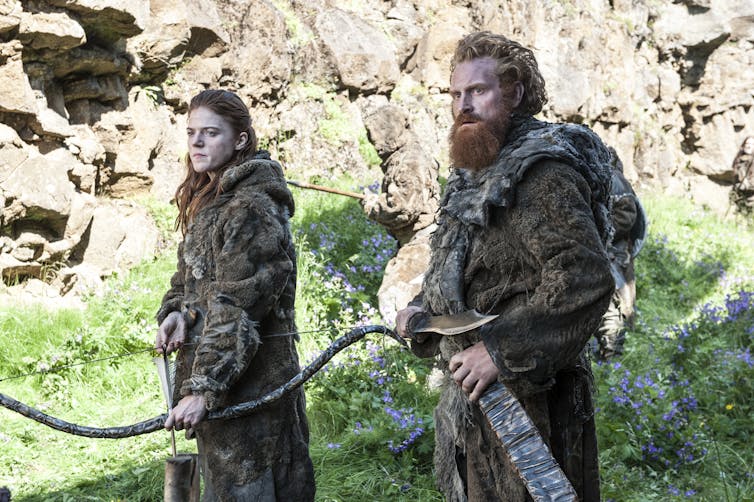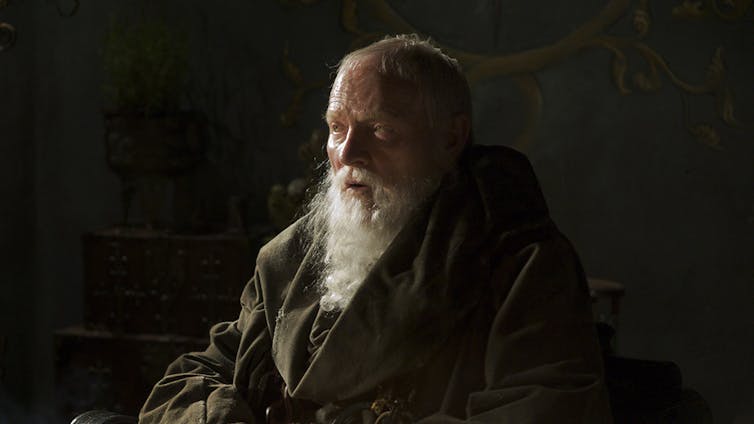Westeros, the primary location of Game of Thrones, has much in common with Western Europe of the middle ages. Its technology is similar, society is feudal and even the climate is roughly the same – save for the odd chilly spell.
But the key difference is Westeros has been more or less like this for some 6,000 years. When you consider the evolution of Western Europe in the time since the fall of the Roman Empire – a mere 1,500 years ago – it’s worth asking how its literary sibling could have stayed so undeveloped. Why has Westeros not experienced an industrial revolution?
The first thing to point out is that economic development is not a simply continuous process, but one of fits and starts. In particular, “step changes” in the availability of general purpose technologies divide eras: once you have experienced a technological transition of this kind, it is difficult to imagine or remember the world as it was before. The great industrial revolution that began in the 18th century was one such transition.
Surging ahead
This revolution did not come about overnight. It was actually the culmination of a long period characterised by “surges” of earlier technologies. Take for instance the stirrup. Its emergence solved the problem of how one could fight from horseback and this in turn enabled the development of the institutions of chivalry.
One surge yet to arrive in Westeros is the cannon. In Europe they were already in use by the time of Crecy in 1345, which would put them well within the technological ambit of Westerosi conflict.
Yet another is banking, which is a necessary condition for investment in building technological capacity; without banks to create money, Westeros is likely to be in a permanent state of monetary shortage with corresponding lack of investment.

The closest thing Game of Thrones has to modern banking is across the sea in Essos, where the Iron Bank of Braavos provides finance for clients across the world. The bank has a modern-day parallel: like the IMF, it has acquired a reputation for engineering regime change when it believes debts might not be repaid. As the books illustrate, financial power leads to political influence:
When princes defaulted on their debts to lesser banks, ruined bankers sold their wives and children into slavery and opened their own veins. When princes failed to repay the Iron Bank, new princes sprang up from nowhere and took their thrones.
However, the Iron Bank’s main interest is in sovereign banking which doesn’t necessarily stimulate the economy: in Robert Baratheon’s reign such loans went largely towards useless pageants and tournaments. The Bank ignores the mundane everyday lending to business that funds activity and investment.
Perhaps a bigger part of the puzzle is why competition among the High Lords doesn’t fuel armed development and in turn the development of military industrial complexes in the seven kingdoms. But Westeros hasn’t always been the war-torn region depicted in Game of Thrones: for the past few centuries the Targaryen kings and their weapons of mass destruction – dragons – kept the individual kingdoms from developing these capacities. There is an interesting non-European parallel here with China, where innovation was held back by a succession of dynasties that wished to prevent threats to the central control.
Industrial growth also requires energy. Coal, more efficient than peat or wood, provided the fuel for the industrial revolution and there is no evidence coal or other fossil fuels exist in Westeros or beyond. The ability to put great engines to work might be beyond even an industrialising Seven Kingdoms.
But beside this, Westeros has labour, plenty of land, a banking industry of sorts and presumably similar resources to 18th-century Europe. It seems most of the conditions are in place for a series of technological surges. So why hasn’t it broken out of the middle ages?
The knowledge economy
The lack of development in Westeros is ultimately explained by the way knowledge is hoarded by one group of people.
In Europe, industrialisation depended on the dissemination of ideas. The more know-how was spread widely, the more people could hear of an innovation and could copy or improve it, building an accelerating cycle of technological development.
In Westeros however, technological innovations are locked up in one institution: The Citadel, home to an order of scholars known as the Maesters (think Maester Luwin of Winterfell who guarded Bran and Rickon, or Grand Maester Pycelle of the court in King’s Landing).

The Maesters sit on the only trove of scientific knowledge in Westeros. Alongside the nobility, they are among the very few able to read and write. Members are embedded within almost all of the castles and great houses of the Kingdom and they seem at this point to be using their control of information and the Raven Net communication system to cultivate their influence.
So ultimately it may take a political shake-up for the Game of Thrones universe to catch up with 18th-century Europe. Breaking up the feudal system with its attendant absurdities would help – after all, a mid-ranking Lord would be ill-advised to attract attention by developing machinery.
And just as the 16th-century Reformation broke the church’s near-monopoly on education and paved the way for future technological advances, so Westeros must reform its Maesters.
Until the Maesters are taken on and education becomes widespread, Westeros is doomed to stay in the same High Medieval rut. Good news for fans of high fantasy, bad news for the characters trapped in it. Winter is coming and it would be nice if they had central heating.





